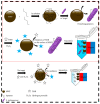Nucleic Acid-Based Nanobiosensor (NAB) Used for Salmonella Detection in Foods: A Systematic Review
- PMID: 35269310
- PMCID: PMC8912873
- DOI: 10.3390/nano12050821
Nucleic Acid-Based Nanobiosensor (NAB) Used for Salmonella Detection in Foods: A Systematic Review
Abstract
Salmonella bacteria is a foodborne pathogen found mainly in food products causing severe symptoms in the individual, such as diarrhea, fever, and abdominal cramps after consuming the infected food, which can be fatal in some severe cases. Rapid and selective methods to detect Salmonella bacteria can prevent outbreaks when ingesting contaminated food. Nanobiosensors are a highly sensitive, simple, faster, and lower cost method for the rapid detection of Salmonella, an alternative to conventional enzyme-linked immunosorbent assay (ELISA) and polymerase chain reaction (PCR) techniques. This study systematically searched and analyzed literature data related to nucleic acid-based nanobiosensors (NABs) with nanomaterials to detect Salmonella in food, retrieved from three databases, published between 2010 and 2021. We extracted data and critically analyzed the effect of nanomaterial functionalized with aptamer or DNA at the limit of detection (LOD). Among the nanomaterials, gold nanoparticles (AuNPs) were the most used nanomaterial in studies due to their unique optical properties of the metal, followed by magnetic nanoparticles (MNPs) of Fe3O4, copper nanoparticles (CuNPs), and also hybrid nanomaterials multiwalled carbon nanotubes (c-MWCNT/AuNP), QD/UCNP-MB (quantum dotes upconverting nanoparticle of magnetic beads), and cadmium telluride quantum dots (CdTe QDs@MNPs) showed excellent LOD values. The transducers used for detection also varied from electrochemical, fluorescent, surface-enhanced Raman spectroscopy (SERS), RAMAN spectroscopy, and mainly colorimetric due to the possibility of visualizing the detection result with the naked eye. Furthermore, we show the magnetic separation system capable of detecting the target amplification of the genetic material. Finally, we present perspectives, future research, and opportunities to use point-of-care (POC) diagnostic devices as a faster and lower cost approach for detecting Salmonella in food as they prove to be viable for resource-constrained environments such as field-based or economically limited conditions.
Keywords: aptamer; bacteria detection; biosensor; magnetic system; nanomaterials.
Conflict of interest statement
The authors declare no conflict of interest.
Figures






References
-
- Ma X., Xu X., Xia Y., Wang Z. SERS aptasensor for Salmonella typhimurium detection based on spiny gold nanoparticles. Food Control. 2018;84:232–237. doi: 10.1016/j.foodcont.2017.07.016. - DOI
-
- Ye Y., Yan W., Liu Y., He S., Cao X., Xu X., Zheng H., Gunasekaran S. Electrochemical detection of Salmonella using an invA genosensor on polypyrrole-reduced graphene oxide modified glassy carbon electrode and AuNPs-horseradish peroxidase-streptavidin as nanotag. Anal. Chim. Acta. 2019;1074:80–88. doi: 10.1016/j.aca.2019.05.012. - DOI - PubMed
Publication types
Grants and funding
- [E-26/203.049/2017] [E-26/010.000.984/2019]; [E-E26/203.187/2019]; [E-26/201.167/2020]/Fundação Carlos Chagas Filho de Amparo à Pesquisa do Estado do Rio de Janeiro
- [313119/2020-1]; [150450/2020-6]/National Council for Scientific and Technological Development
- [88887.518753/2020-00]/Coordenação de Aperfeicoamento de Pessoal de Nível Superior
LinkOut - more resources
Full Text Sources
Miscellaneous

